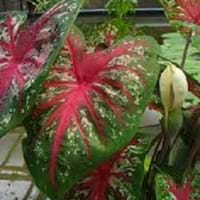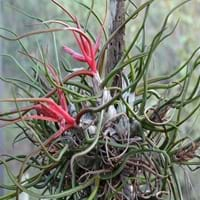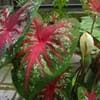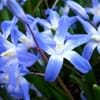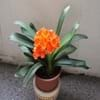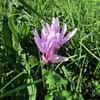Life Span
Annual and Perennial
Perennial
Type
Tender Perennial
Epiphyte
Origin
Southern Europe, Mediterranean
Southeastern United States, Latin America and the Caribbean, Central America, South America
Types
Not Available
Not Available
Habitat
gardens, Grassland, Prairies, tropical environments, Tropical regions
Humid climates
USDA Hardiness Zone
7-9
10-15
Sunset Zone
4, 5, 6, 14, 15, 16, 17, 18, 19, 20, 21, 22, 23, 24
H1, H2, 23, 24
Habit
Mat-forming
Rosette/Stemless
Flower Color
White, Green
Purple
Flower Color Modifier
Bicolor
Not Available
Fruit Color
Green
Non Fruiting Plant
Leaf Color in Spring
Gray Green
Green, Gray Green, Pink
Leaf Color in Summer
Gray Green
Green, Gray Green, Dark Green
Leaf Color in Fall
Gray Green
Green, Gray Green, Dark Green
Leaf Color in Winter
Light Green
Gray Green, Dark Green, Rose
Leaf Shape
Linear
Needle like
Plant Season
Spring, Summer, Fall, Winter
Spring, Summer, Fall, Winter
Sunlight
Full Sun, Partial Sun
Partial Sun, Partial shade
Type of Soil
Loam, Sand
Not Available
The pH of Soil
Neutral, Alkaline
Not Available
Soil Drainage
Well drained
Not Available
Bloom Time
Spring, Late Spring, Early Summer, Summer, Late Summer, Early Fall
Spring, Late Spring
Tolerances
Drought
Not Available
Where to Plant?
Container, Ground, Pot
Container, Ground, Pot
How to Plant?
Seedlings, Stem Cutting
Divison
Plant Maintenance
Medium
Medium
Watering Requirements
Allow soil to be completely dry in between waterings, Water Deeply, Water less during winter
Needs small amount of water, Needs Very high moisture
In Summer
Lots of watering
Lots of watering
In Spring
Moderate
Moderate
In Winter
Average Water
Average Water
Soil pH
Neutral, Alkaline
Not Available
Soil Type
Loam, Sand
Not Available
Soil Drainage Capacity
Well drained
Not Available
Sun Exposure
Full Sun, Partial Sun
Partial Sun, Partial shade
Pruning
Cut or pinch the stems, Do not prune during shooting season, Prune if you want to improve plant shape, Prune prior to new growth, Remove deadheads
Remove damaged leaves, Remove dead branches, Remove dead leaves, Remove dead or diseased plant parts
Fertilizers
No fertilizers needed
All-Purpose Liquid Fertilizer
Pests and Diseases
fungus, Insects, Red blotch
Pests and diseases free, Red blotch
Plant Tolerance
Drought
Drought, Heat And Humidity, Wet Site
Flower Petal Number
Single
Single
Foliage Texture
Fine
Fine
Foliage Sheen
Matte
Glossy
Attracts
Bees, Birds, Butterflies
Hummingbirds
Allergy
Skin irritation
Not Available
Aesthetic Uses
Beautification, Showy Purposes
Not Used For Aesthetic Purpose
Beauty Benefits
Not Available
Not Available
Environmental Uses
Air purification
Air purification
Medicinal Uses
No Medicinal Use
Not Available
Part of Plant Used
Whole plant
Not Available
Other Uses
Showy Purposes
Not Available
Used As Indoor Plant
No
Yes
Used As Outdoor Plant
Yes
Yes
Garden Design
Alpine, Container, Edging, Foundation, Groundcover, Mixed Border, Rock Garden / Wall
Hanging Basket, Tropical
Botanical Name
CALADIUM 'Aaron'
TILLANDSIA bulbosa
Common Name
Aaron Caladium, Angel Wings, Fancy-leaved Caladium
Bulbous Air Plant, Dancing Bulb
In Hindi
Aaron Caladium
Dancing Bulb
In German
Aaron Caladium
Dancing Bulb
In French
Aaron Caladium
Dancing Bulb
In Spanish
Aaron Caladium
Dancing Bulb
In Greek
Aaron τροπικό φυτό
Dancing Bulb
In Portuguese
Aaron Caladium
Dancing Bulb
In Polish
Aaron Caladium
Dancing Bulb
In Latin
Aaron Caladium
Dancing Bulb
Phylum
Tracheophyta
Tracheophyta
Class
Liliopsida
Magnoliopsida
Family
Araceae
Bromeliaceae
Genus
Caladium
Tillandsia
Clade
Angiosperms, Monocots
Angiosperms, Commelinids, Monocots
Tribe
Not Available
Not Available
Subfamily
Aroideae
Tillandsioideae.
Number of Species
Not Available
Season and Care of Aaron Caladium and Dancing Bulb
Season and care of Aaron Caladium and Dancing Bulb is important to know. While considering everything about Aaron Caladium and Dancing Bulb Care, growing season is an essential factor. Aaron Caladium season is Spring, Summer, Fall and Winter and Dancing Bulb season is Spring, Summer, Fall and Winter. The type of soil for Aaron Caladium is Loam, Sand and for Dancing Bulb is Not Available while the PH of soil for Aaron Caladium is Neutral, Alkaline and for Dancing Bulb is Not Available.
Aaron Caladium and Dancing Bulb Physical Information
Aaron Caladium and Dancing Bulb physical information is very important for comparison. Aaron Caladium height is 30.50 cm and width 30.50 cm whereas Dancing Bulb height is 12.70 cm and width 15.20 cm. The color specification of Aaron Caladium and Dancing Bulb are as follows:
Aaron Caladium flower color: White and Green
Aaron Caladium leaf color: Gray Green
Dancing Bulb flower color: Purple
- Dancing Bulb leaf color: Green, Gray Green and Pink
Care of Aaron Caladium and Dancing Bulb
Care of Aaron Caladium and Dancing Bulb include pruning, fertilizers, watering etc. Aaron Caladium pruning is done Cut or pinch the stems, Do not prune during shooting season, Prune if you want to improve plant shape, Prune prior to new growth and Remove deadheads and Dancing Bulb pruning is done Remove damaged leaves, Remove dead branches, Remove dead leaves and Remove dead or diseased plant parts. In summer Aaron Caladium needs Lots of watering and in winter, it needs Average Water. Whereas, in summer Dancing Bulb needs Lots of watering and in winter, it needs Average Water.
